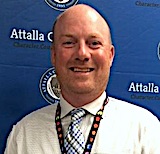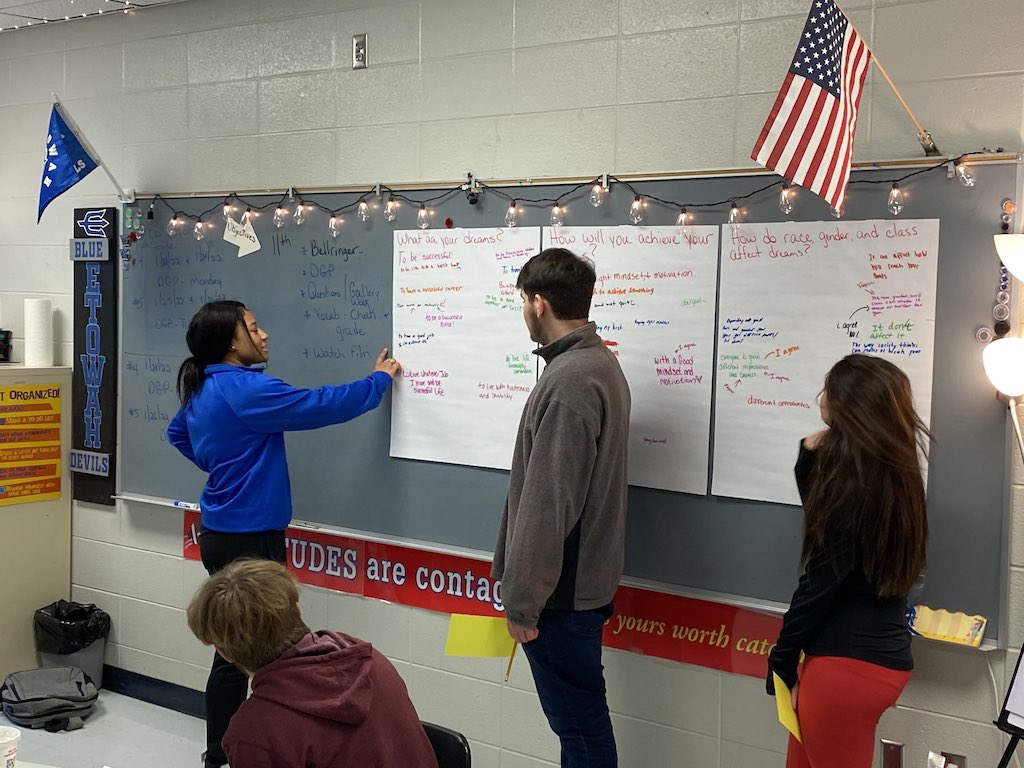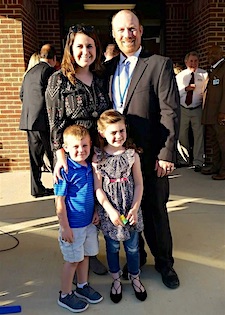 By Dr. Nate Ayers
By Dr. Nate Ayers
Principal
Etowah High School
Attalla City Schools
As a classroom teacher, there is nothing more important than protecting instructional time and avoiding distractions within the learning environment.
When a visitor enters the classroom, the entire dynamics of that class change, and instantly the teachers are in recovery mode. Unfortunately, this scene is played out in classrooms across our state daily, but does this have to be the case? How can we protect the integrity of the classroom while at the same time help highlight and improve instructional delivery in the classroom?
Our vision at Etowah High School is very simple: Be visible and be intentional when it comes to getting into classrooms, and while there, make sure to have meaningful conversations with students about what they are learning.
Our teachers love to visit and be visited
We are blessed at Etowah High School to have a school full of teachers who love having visitors in their classrooms. One of the hardest things about social distancing and some of the other restrictions that occurred during Covid was the impact that it had on administrators and teachers alike spending time visiting classrooms.
The conversation that can be had and the knowledge that can be gleaned from simply visiting another teacher’s classroom is extremely valuable and should not be overlooked, whether we’re hosting instructional rounds for visiting schools and educators or sharing what’s going on in our classrooms with our own school colleagues.

While this concept seems easy, it does take an intentional daily focus on protecting time to get into classrooms. It also has to be viewed as an important piece to the instructional growth at the system level. In Attalla City Schools, we are led by a central office full of people who spend a substantial amount of time in our schools. There are not many days that pass when the superintendent of our school system is not on our campus having discussions with staff and students.
Our leadership goal: Visit every day in every classroom
Every classroom, every day, even on days when it’s tough. This motto is one that our administrators and our instructional partner/coach strive to meet every day at our school. We take it personal if a student makes a comment that they have not seen one of us in the classroom that day.

We do understand that there are days, especially in the Spring, when this does not happen, but those days should never become the norm. We have to protect this time and keep the first things first. Now that we have time protected in our schedule, what does it look like when we get there?
We do not take devices or notepads when we do classroom visits. Our thought is that if we are writing notes or typing in a document, we might lose something that we would have seen if we were fully present in what was being taught. We have conversations with students while the instruction is being delivered to see how the student relates the lesson to their personal plan moving forward.
This process was a common theme when we conducted goal setting meetings with our teachers this past summer. As a school, we wanted our students to have ownership of their learning and be able to link what they are learning to their career path or be able to explain how the concept at hand gave them foundational knowledge to take the next step in that course. While “I can statements” are important, we wanted our students to be able to do more than just recite them.

Making the shift to ATOT
Our focus on getting in the classroom has now begun to help us in a different way as we make the shift to the Alabama Teacher Observation Tool. Just like any new implementation, there were skeptics and educators statewide who saw this as another constraint placed on our teachers.
As a district we’d been using the ELEOT learner-centered tool, and our teachers were not quick to accept a teacher centered evaluation tool. For our seasoned teachers and many others across the state, a teacher centered evaluation model could only mean one thing – the return of PEPE.
Knowing the hesitation and common thoughts that were out there, our administration went to the ATOT training guarded but understanding that this was a shift that we were going to make. What we gained that day was nothing like what we were expecting.

We left the training that day and immediately began to think about how we could turn this around to our staff. As a leadership team, we felt as though foundational knowledge had to be the first step, so we committed two days worth of our shared-lunch professional development to walk our teachers through the scoring process and answer any questions they might have on what the categories were and what each of them meant.
We also believed that something more than a foundational understanding was needed prior to official ATOT observations being conducted. To do this, we took an idea that was discussed by Dr. Melissa Shields at our training and asked the teachers to give up 20 minutes of their planning block to conduct an ATOT on one of their coworkers.
The feedback that we have received from that experience has been very promising, and our teachers now know exactly what we feel like as administrators when we are looking for specific things during the observation.
After one of the observations, our observing teacher spoke of the excitement that both she and the observee felt when they both realized an innovative way to incorporate student choice into a lesson on fractions. As we progress into actually conducting these observations and documenting our results, we feel like our teachers will now have a better understanding of what their scores reflect and how to improve them.
We’ll build on our norm of daily walkthroughs
As a school, we plan on conducting these observations just like we conduct our daily walkthroughs. Our thought process is to change as little as possible because administration and other visitors being in the classrooms is a norm at our school.
We also do not plan on carrying anything in with us during the visit. Instead, we would rather be taking mental snapshots of what we see in our 20 minutes and then complete the ATOT documentation after we exit the room. Again, this is a norm during our walkthroughs. Thanks to this “walkthrough culture,” in fact, our students will never know that anything outside of the normal is going on.
Going forward, it is our plan both as a school and a system to use our ATOT data to develop meaningful professional learning communities that address specific areas of growth that our observations uncover. Only time will tell if our foundational work allows for a smooth transition to this new observation tool, but we do feel like the steps we have taken give our teachers the best shot at understanding and using the ATOT moving forward.
Feature image: Dr. Melissa Shields (@mjshields) during EHS instructional rounds.
 Nate Ayers, Ed.D, is principal of Etowah High School. This is his 15th year in education and his sixth with Attalla City Schools. Nate served four years as AP at Etowah Middle and was a science teacher for nine years at Holly Pond High School in Cullman County, where he also coached football, basketball, and track and field. He earned his Doctor of Education degree in Instructional Leadership from The University of Alabama.
Nate Ayers, Ed.D, is principal of Etowah High School. This is his 15th year in education and his sixth with Attalla City Schools. Nate served four years as AP at Etowah Middle and was a science teacher for nine years at Holly Pond High School in Cullman County, where he also coached football, basketball, and track and field. He earned his Doctor of Education degree in Instructional Leadership from The University of Alabama.
Nate and his wife Laney have two children, Parker (10) and Walker (7). If you have questions about Etowah High’s walkthrough culture and classroom visitation norms, you can reach Nate at [email protected].

0 Comments on "How Our ‘Walkthrough’ Norms Are Helping Us Transition to ATOT"